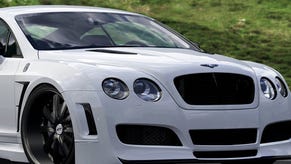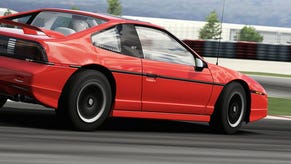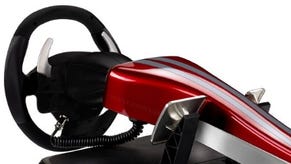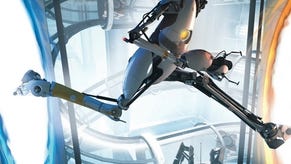Tech Analysis: Forza Motorsport 4
Including a comparison with GT5 2.0.
Of more interest is Kinect's head-tracking support: it makes some minor adjustments to the view in any of the camera modes, but really comes into its own in the cockpit view, where you can turn your head to anticipate corners and look at rear-view and wing mirrors: Kinect tracks both head location and where you're looking to adjust the in-game perspective but unfortunately it is rather laggy. On the plus side though, Kinect can be relocated to your bedroom/office/study, and can be calibrated to track your head from just a couple of feet away. Indeed, the accuracy of the tracking likely improves for doing so.
Another stand-out addition designed to get the most out of Turn 10's modelling work is the introduction of the new Autovista mode. The basic idea of being able to check out high-quality CG versions of the game's vehicles might not sound too exciting (we saw something similar in terms of the basic concept back at the launch of the Xbox 360 in Project Gotham Racing 3) but the execution in Forza Motorsport 4 is really rather special.
The artists' recreations of the showcased cars are beautiful, but in truth, it's not just about poly count: Autovista looks uncannily realistic owing to the new lighting techniques and the shader work done on rendering materials: steel, aluminium, cloth, plastics, leather, carbon fibre - there are no low resolution textures to speak of and elements retain fidelity even when viewed just six inches away. Open doors, peer at engines, pore over the interiors and feel the quality, while well-designed HUD elements pop-up with appropriate facts and figures. Each vehicle also includes a Jeremy Clarkson-voiced Top Gear review too. Autovista serves no actual purpose from a gameplay perspective, but it emphasises the work that Turn 10 has put into its cars and it's a wonderful vehicle for the developer to illustrate the love of motorsport that it shares with its audience.
If there is a criticism to make of the game, it's that the developers have opted to polish, refine and improve their existing offering as opposed to branching out and creating any stand-out new features for the core driving experience. Turn 10 has zeroed in a specific range of enhancements designed to make the game they've already made look better, play better and to further boost the superb Xbox LIVE community features that have defined the series.
This focus ensures that the game is remarkable, but it's difficult to avoid the conclusion that Polyphony Digital remains the pioneer of the console driving genre in terms of the breadth of racing types being covered. It's not just about the wet weather or night-time racing modes that Dan Greenawalt discussed earlier - snow and ice conditions are missed and there's no rallying. However, as with previous Forza games, there is still a great deal of cross-over with Gran Turismo 5 - allowing us to put together this fun comparison of the new game up against the newly patched spec 2.0 version of Polyphony's title. What we have here is the player using the same car on the same tracks. We've tried - with varying level of success - to ensure equivalent amounts of vehicles at any given point.
The comparison is intriguing on a number of levels: it demonstrates that the aesthetic look of the two games is very, very different - especially in terms of the lighting, and that while Forza's performance level is wholly consistent at 60FPS, GT5 can drop frames and tear, even at 720p (with further frame-rate drops if running in 1080p or 3D modes). Also remarkable is how completely different the audio scheme is between the two games. On these courses at least, there's a pretty strong argument that Forza has considerably more track detail, but you can make up your own mind with this Forza 4/GT5 comparison gallery.
The overall impression we get from playing both games back-to-back is that each has its own strengths: in terms of the handling and audio Turn 10 could well have moved ahead of its competition while Polyphony's minute attention to detail (to the point of implementing working headlights/dynamic shadows in the cockpit view) plus the sheer range of different driving scenarios remains second to none. Both titles excel in their own ways - especially in terms of visuals - and we have the feeling that motorsport fans probably own both consoles and are equally invested in both games. We aim to take a look at how these games play with a number of different steering wheel peripherals in a future Digital Foundry hardware article.
So where now for Forza Motorsport? With the Xbox 360's successor now in development and allegedly slated for an E3 debut next year, will we see another Forza Motorsport on the current platform, or will the developers jump ahead to the next? Could we even see a dual console release for the next game in the series, with appropriate enhancements in place for those invested in Microsoft's new console? We're swiftly approaching an exciting time of transition and when we have developers as talented as Turn 10 producing games of this quality on six-year-old hardware, the next-gen possibilities are mouth-watering, to say the least...
Bonus Material: It appears as though Adobe is making progress in getting its Flash player capable of rendering more demanding video, so we've prepared 60FPS versions of each of the main videos in this article. Click on the links below, and be sure to press the full-screen button for the smoothest performance. Note that the High/720p HD options run at the standard internet streaming 30 frames per second.
- Forza Motorsport 4 performance analysis
- Image-based lighting showcase
- Gran Turismo 5 vs. Forza Motorsport 4 720p performance analysis
- Digital Foundry vs. the reasonably priced car






